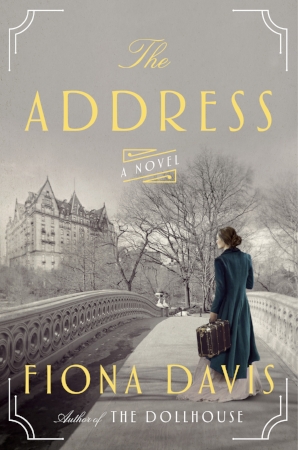WomensHistoryReads interview: Fiona Davis
I'm thrilled to welcome bestselling author Fiona Davis to the blog today for a fun Friday #WomensHistoryReads Q&Q&Q&A! Especially because I'm currently devouring her debut novel THE DOLLHOUSE on audio and I am hooked. She talks about THE DOLLHOUSE below as well as her follow-up, THE ADDRESS, both of which will send you into fits of envy over classic New York City real estate. And I can't wait for her upcoming THE MASTERPIECE, inspired by an art school once hosted within Grand Central Terminal! Don't miss her answers about the iron-clad rules of the Barbizon Hotel For Women (no pants!) and a chance to see Cousin Matthew like you've never seen him before.
Fiona Davis photo credit: Kristen Jensen
Greer: Tell us about a woman (or group of women) from the past who has inspired your writing.
Fiona: I got the idea for my first book, THE DOLLHOUSE, after looking at an apartment for sale in what used to be the Barbizon Hotel for Women and is now a condo, here in New York City. I learned that a group of older women who’d been residents for decades – back when boys weren’t allowed above the public areas and you couldn’t wear pants to cross the lobby – had been grandfathered in to rent-controlled apartments on the 4th floor during the renovation. I was curious about their perspectives, how they’d seen the building and the city change over time. For example, in 1966 you could stay at the Barbizon Hotel for Women for a week for $6.75, while today the penthouse is going for $17 million. I couldn’t shake the idea, and decided I had to write a novel about it. While the characters in the novel are fictional, the ladies of the fourth floor continue to inspire and fascinate me.
Greer: And thank goodness for that. Do you consider yourself a historian?
Fiona: I’m more of a fiction-writing journalist with a love of the past, I’d say. I use my journalism background when I research my novels to uncover historical nuggets that may have been lost to history, and then embed them in the story. For example, for THE DOLLHOUSE, set at the Barbizon Hotel, I tracked down and interviewed women who’d lived there back in the day. Their stories were both hilarious and sometimes shocking. For my second book, THE ADDRESS, which is set in the Dakota, one of NYC’s oldest apartment houses, I was able to get a couple of amazing tours of the building by current residents, from the basement to the top floors where the servants used to live. For my third book, which takes place in Grand Central Terminal and comes out in August, I discovered that an art school existed at the very top of the building’s east wing from the 1920s to the 1940s. During an interview with an architecture historian, I learned of a female artist who made a huge splash during the Jazz Age and then disappeared, and she became the inspiration for one of the protagonists.
Greer: What book, movie or TV show would your readers probably be surprised to find out you love?
Fiona: High Maintenance is a series I adore. It’s about an affable, bicycle-riding pot dealer in Brooklyn. Each episode focuses one or two of his clients, and are narrative gems featuring quirky twists – the perfect embodiment of a visual “short story.” I really enjoy the diverse cast, which includes some of New York’s best actors and actresses. Be sure to check out the early, ten-minute versions that appeared on Vimeo before it got picked up by HBO. For example, there’s one of Downton Abbey’s Dan Stevens as a cross-dressing stay-at-home father. Moving, funny, and smart.
Greer: Okay, definitely intrigued enough to give it a shot!
Fiona: My question for you is: If you were told you could time-travel back to a different time and place for a couple of weeks, where would you go, and in what era?
Greer: So many possibilities! I just finished doing boatloads of research about Northern California, including San Francisco and the Napa Valley, in the 1880s, so the temptation to go there might be too strong to resist. (Especially if I could go now, while I still had time to fact-check my next book before it comes out in 2019! Wouldn't that be a lovely opportunity?) But San Francisco was so interesting then, when they were really coming out of the wild frontier period post-Gold Rush, trying to establish the city as a major capital of culture, society, all the things the East Coast cities had in spades. And most of the architecture from that period was wiped out in the 1906 earthquake, so it's one of the harder places to recreate how it must have looked then, based on how it looks today. You still have the hills and the Bay, those have always been there, but the buildings and people and traffic over that topography, I'd love to see how it all fit together in those years.

